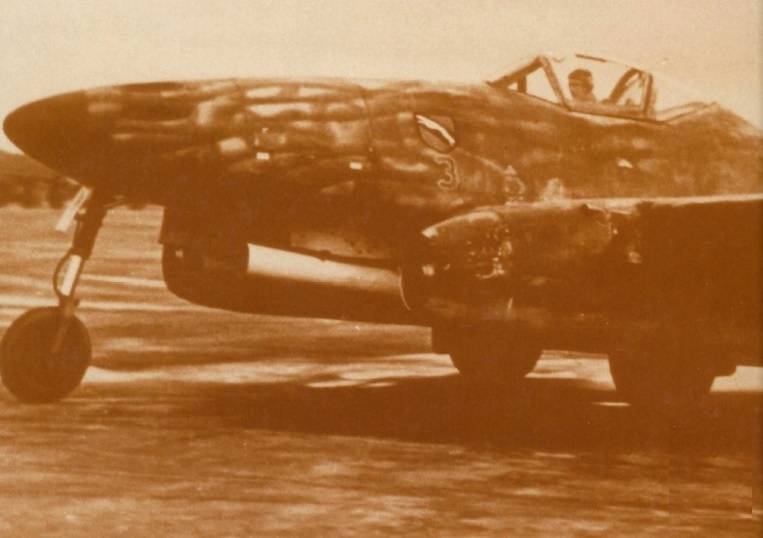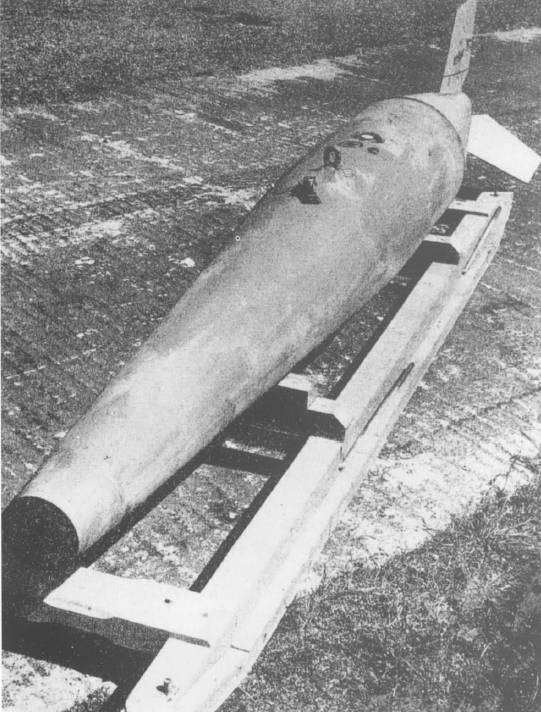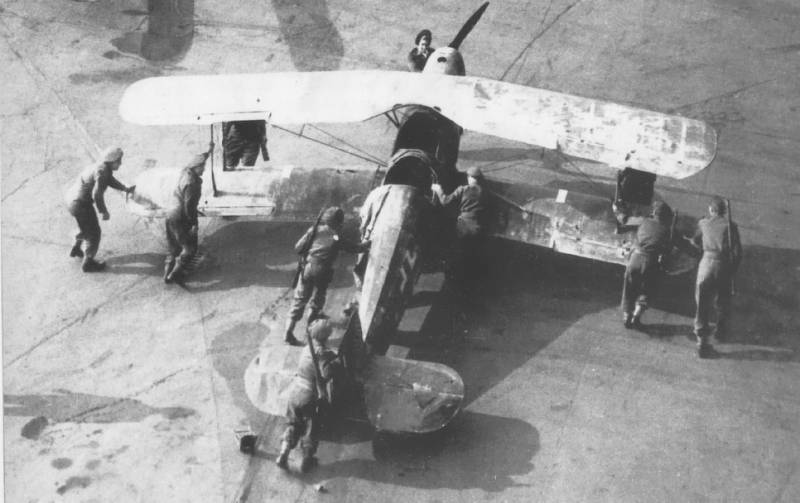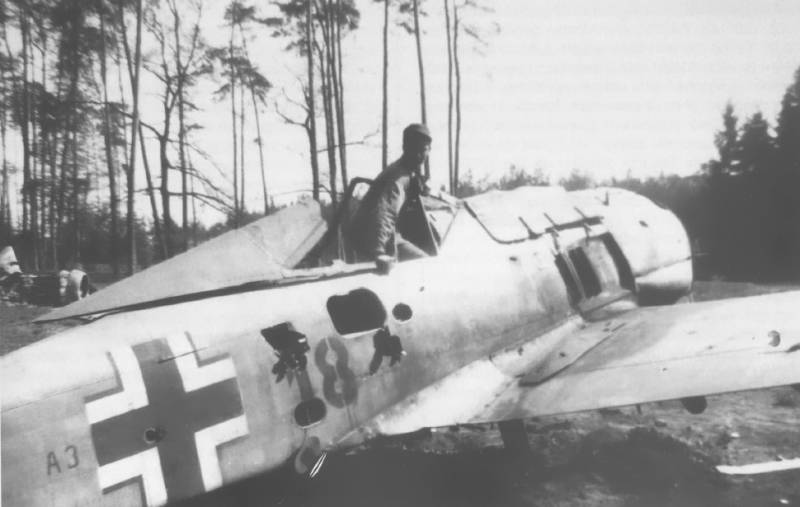“Luftwaffe in 45. Recent flights and projects. Continued. Part of 3

This text is a continuation of the abridged translation of the book “Luftwaffe'45. Letzte Fluge und Projekte ”, made by a colleague of NF68, is the author of translations of many interesting topics related to the German air force. The illustrations are taken from the original of the book, the literary processing of the translation from German was made by the author of these lines.
Subjected to powerful enemy attacks, the compound flew over Hannover towards Lüneburg. Passing over Schwerin, she continued on her way to Husum. As early as May 4, 1945, some crews of the night attack squadron continued to fly, delivering the last desperate blows to the British ground forces. NSGr Night Attack Squadron. 1 (Süd) at the end of the war was in Upper Bavaria. On May 3, the squadron's flight units were based in Albing. At the same time, the ground personnel of this squadron took part in battles unusual for them against enemy ground forces. NSGr Night Attack Squadron. 1 (Süd) ceased fighting on May 9, 1945 in Bad Reichenhal. NSGr Night Attack Squadron. 2 was also part of the Hallensleben combat unit. After the disbandment of this compound, the squadron acted independently. The airfields in Ostheim and Cologne-Wahn, on which the squadron was based, were soon abandoned due to suitable American units, and in the early days of March 1945 the NSGr squadron. 2 relocated to an area near Westerwald (from Westerwald). From mid-March 1945, the NSGr squadron. 2 and NSGr. 1 west of the Rein River, they were fighting together, trying to destroy the bridge at Remagen. On March 13, the airfields of both squadrons were attacked by American aircraft B-26 and R-47 from the 9th Air Army. The enemy during these attacks destroyed 22 of the 26 located on taxiways Ju-87 D-5. After the squadron left the intermediate base at Oberhessen and Westerwald, it was relocated to southern Germany. Then, at the end of March, the NSGr squadron. 2 was relocated to a well-trained Bayreuht airfield. Further, from April 19, one squadron group was based at the airport in Straubing. Dangerous deep breakthroughs tanks the enemy on the Autobahn towards Regensburg was a danger to the group, and on May 2, 1945, the last crews with their Ju-87 D-5s returned back to the airfield in Albing. Some crews were based at the airport in Holzkirhen, where on May 8, the crews blew up almost all of the surviving aircraft. NSGr Night Attack Squadron. 4 from the end of 1944 was able to achieve great success, but at the same time the losses of the squadron were sensitive. October 15, 1944 aviation group 1 / NSGr. 4 based in Lübben. The 2nd squadron of this group was armed mostly with aircraft of the Ju-87 D-3 "N" and D-5 "N" type with flame arrester and additional navigation equipment, which allowed operating at night at low altitudes. On February 1, 1945, the headquarters of the air group had an additional one Ju-87 5 D-5 and five aircraft of the Si-204 D-1 type.
In total, the air group, despite the losses of the last weeks, had more than thirty aircraft of the Ju-87 type. In January and February, the 3 squadron of the group in the battles of Ober-Glogau, Stephansdorf, Stephansdorf, Neise-Möckendorf and Bommisdorf (Bömmischdorf) again lost many crews. Until February 27, the surviving crews flew from Kamenz airfield (Kamenz), located southeast of Dresden (Dresden), striking in the Bautzen area. In the early days of March, the Ju-87 D from the 1 / NSGr night attack groups. 4 took part in heavy fighting in the Kolberg area (Kolberg), but because of bad weather, the participation of attackers in the battles brought only a small success. Most of the bombs dropped from AB 250 and AB 500 containers did not hit the target. Meanwhile, the Red Army units, due to the fact that the length of the front line was shrinking every day, managed to significantly increase the concentration of anti-aircraft artillery, first of all it affected mobile and tank units, therefore attacking the enemy for Ju-87 D crews became more and more dangerous. 21 in March, the compound was armed with a staff squadron of two aircraft such as the Ju-87 D and 3 aircraft of the type Si 204. More 16 airplanes of the Ju-87 type were part of the 1 squadron, 12 airplanes in the 2 squadron and 19 airplanes in the 3 squadron of the group. From the report of the squadron NSGr. 4 follows that in March 1945 the planes of this squadron attacked the transport lines of the Soviet troops. However, surprisingly quickly organized opposition of the Soviet troops led to the fact that attempts at night raids carried a danger for the German aviation itself, while the Red Army paid special attention to protecting bridges and important areas from air strikes.
April 1, 1945 the headquarters of the NSGr night attack aircraft squadron. 4, being in the area of responsibility of the 3rd Aviation Division of the 6th Air fleet, used for night strikes at least 2 or 3 aircraft of the type Si-204 D-1 with containers for bombs. On the night of April 8, 1945, 6 aircraft of the Ju-87 type were supposed to lose 2040 kg for the surrounded garrison of Breslau. Ammunition and equipment enclosed in containers, but due to bad weather in the area of the city, three aircraft were forced to return to their airfield. At the same time, 16 Ju-87 D escorted by 8 piston fighters flew to Küstrin. A little later, this group of planes hit the Soviet troops moving along the Reichsavtoban in the area between Breslau and Liegnitz. On April 9, 1945, this relatively powerful night attack aircraft squadron still had more than forty-five aircraft such as the Ju-87 D-3, Ju-87 D-5, and Si-204 D-1. On April 13, 8 aircraft from this squadron flew to find suitable targets in the Reichsavtoban area near Breslau, and on April 17, 23 aircraft of the Ju-87 D type from the 2nd and 3rd groups of the NSGr squadron. 4 struck the enemy forces in the Ratibor area. One Si-204 D-1 aircraft in the Brünn area of two AB 250 containers dropped 8 SD 70 bombs on enemy positions.

Heavy aircraft bomb torpedo 1400 X
On the night of April 24, the X-NUMX of the Ju-16 aircraft, with the support of the Ju-87, which dropped the bombs, attacked the enemy forces in the Rathstock area. In this case, primarily used containers AB 88 and AB 250. 500 May Air Group 3 / NSGr. 2 was based in Olmutz-Süd (Olmutz-Süd), the 4 / NSGr air group. 3 was based in Ludwigsdorf (Ludwigsdorf). At that time, the previously mentioned 4 Squadron of O. Weiss (Otto Weiß) was part of the Weiß combat unit and operated in the area of responsibility of the 3 Land Army. This squadron was based at the airfield in Vernoykheny (Werneuchen). Squadron NSGr. 17 was redeployed from Norway near Frankfurt an der Oder (Frankfurt / Oder), from where it delivered strikes that were of particular importance to enemy forces in the Berlin area and on the front section of the Oder River. 8 February 1 The Ju-1945 D-87 aircraft and some types of light auxiliary aircraft (the 5-I squadron was armed with mostly outdated Ar-4 and Go-66) were used to strike at the enemy. Until February 145, all three squadrons were based at the Werneuchen airfield. On the night of 27 and 23 in March, the 24 Ju-48 of NSGr Squadron. 87 attacked the enemy's bridgehead at Görlitz, thereby somewhat alleviating the plight of its ground forces in this sector of the front. March 8 the same aviation squadron successfully hit the enemy positions attacking the 25 Infantry Division. In addition, accurate strikes on the enemy under Lebus (Lebus) for a while reduced the onslaught of Soviet units. During the seven days of March, a total of 712 Ju-187 and two Go 87 were hit on the enemy.
Biplanes were used on the Eastern Front until the end of the war. The picture Go 145
Many times these aircraft during combat missions were accompanied by the Ju-88 and Ju-188, which aimed attack aircraft at targets, while dropping the LC 50 bombs. Only 1 on April German aircraft made 37 combat missions. For more German aviation was no longer able due to lack of fuel. Squadron night attack aircraft NSGr. 8 dropped bombs using an AB 61 500 container, an AB 143 250 container with SD 10 bombs, and an X XUMUMX ABNNX container with SD-262 bombs. In addition, bombs were also dropped from two AB 250 containers. Later, the crews of German aircraft dropped six SC 1 bombs, 70 SD 500 bombs and 19 SD 250 bombs. 250 April 70 11 Ar 1945, Go 32 and several Ju-66 D-145 took part in the raid during the last heavy strike on the enemy. The attacks were carried out on enemy troops stationed in the Görlitz region (Görlitz), after which the entire squadron was redeployed to the north of Germany, where from time to time minor strikes were made on the enemy. For a larger squadron, due to lack of fuel and ammunition, was unable to. In early May, the high command of the Luftwaffe near Schleswig disbanded another combat-ready group. In defensive battles squadron night attack aircraft NSGr. 87 has played a special role. Despite the fact that the squadron was a rather weak compound, the experienced crews of this squadron delivered sensitive strikes on some columns of the American and British ground forces. Alas, the lack of fuel and spare parts reduced the effectiveness of this squadron.
At the end of December 1944, the X-NUMX Ju-12 aircraft remained in the squadron. From the beginning of January 87, all combat-ready aircraft were concentrated in the staff squadron and in the 1945 and 2 squadrons, which made it possible to strengthen the connection. Over the next six nights, the squadron's airplanes made 3 more sorties. On February 90, the squadron headquarters was moved from Bovolone to Villafranc. The first squadron was equipped with FW-2 F-190 aircraft.
FW 190 F-8 from III./KG 200, returned from combat mission. Drawn attention to the holes in the body, formed as a result of hits shells
Suddenly, until the end of February, 12 high-speed fighter-bombers of the 1 / NSGr air group were sent to the squadron. 9. Both other squadrons and the headquarters of the group flew in conventional aircraft Ju-87 D. 1 March in the group were still 26 aircraft. Despite the fact that everything in the German armed forces had already been destroyed, the number of Ju-87 D night attack aircraft in the NSGr squadron. 9 increased to 27 units by the end of March. 1 April the number of aircraft in the squadron increased to 60, including 40 Ju-87 D. According to the GenQ 6 division of the Luftwaffe, on 9, April 1945. in the NSGr squadron. 9 in service still had 35 serviceable aircraft FW-190 and Ju-87. The last time these planes made 22 and 23 sorties on April, when a mixed group consisting of 20 FW-190 and Ju-87 D aircraft struck Moden forces at dusk. 27 April The last five FW-190 F-8 and X-NUMX Ju-13 D-87 / D-3, under pressure from the enemy, were transferred to Innsbruck, where the squadron remained until the end of the war. Squadron night attack aircraft NSGr. 10 since mid-September 1944 It was located on the southern wing of the Eastern Front in the north of the Balkans. Then this squadron took part in the battles in Hungary. At the end of March 1945 NSGr squadron headquarters. 10 had two Ju-87 D-5, and on March 30 these aircraft took part in the last big operation. The next day, 1 / NSGr.10 had seventeen Ju-87 D. Then the 2 / NSGr.10 group was relocated to the west, and as of 3 in May 1945. based in Wels (Wels), where it was disbanded. In order to reduce pressure on the German front from the Allied air forces on the Western front, the German command 16 September 1944. a special aviation connection was organized. The commander of this compound was appointed Lieutenant Colonel R. Hallensleben (Rudolf Hallensleben). This unit consisted of the third group of the KG 3 squadron, the KG 51 squadron and the 2 squadron of the NSGr squadron. 2. Later the Schenk group, equipped with Me 262 airplanes (3 / KG 51), entered this connection. From November 26, this unit was subordinated first to the second aviation corps, and then to the 15 th aviation division. On 31 December 1944 the “Hallensleben” connection had X-NUMX's Ju-87 D-87 and D-3 aircraft, although enemy night fighters increasingly attacked German attack aircraft. In mid-December, the German offensive in the Ardennes came to the fore. In addition to strikes at numerous targets on communications and enemy positions, individual crews of German aircraft successfully bombed enemy ships that marched along the Maas River. The German offensive in the Ardennes failed by the end of December, and the Allied forces regained their former positions. In early January, 1945 fierce battles were fought in the cauldron at Baston (Baston), where the enemy was slowly pushing German troops east. Despite numerous losses in recent weeks, 1945 was in early January On this section of the front of the 86-ti Ju-87 49 aircraft were still operational. Despite the constant strikes of enemy aviation against German aircraft manufacturers, in January 1945. the troops received another 29 aircraft, and by the end of January the X-NUMX of the Ju-90 D-87 and D-3 aircraft were transferred to the air units. Soon, the loss of connections from the impact of the enemy amounted to 13 aircraft in the air and another 31 aircraft were destroyed on the ground. Of these, 17 accounted for the squadron NSGr. 1 and 14 on NSGr squadron. 2. As losses increase, the number of aircraft in the German aviation units decreased. Until mid-February, German aviation struck at night at enemy troops, and this connection was disbanded on February 21. Over 3100 sorties, more than 140 aircraft were lost, of which 30 were lost as a result of air attacks. The losses of the crews of German aircraft forced us to more and more reduce the training time of new crews, at the same time, enemy aircraft became more numerous. The remains of the squadron NSHr. 1 and NSGr. The 20 was transferred to the 14 Air Division. In addition to its FW-190, in the night squadrons of this aviation division there were several Ju-87.


Information